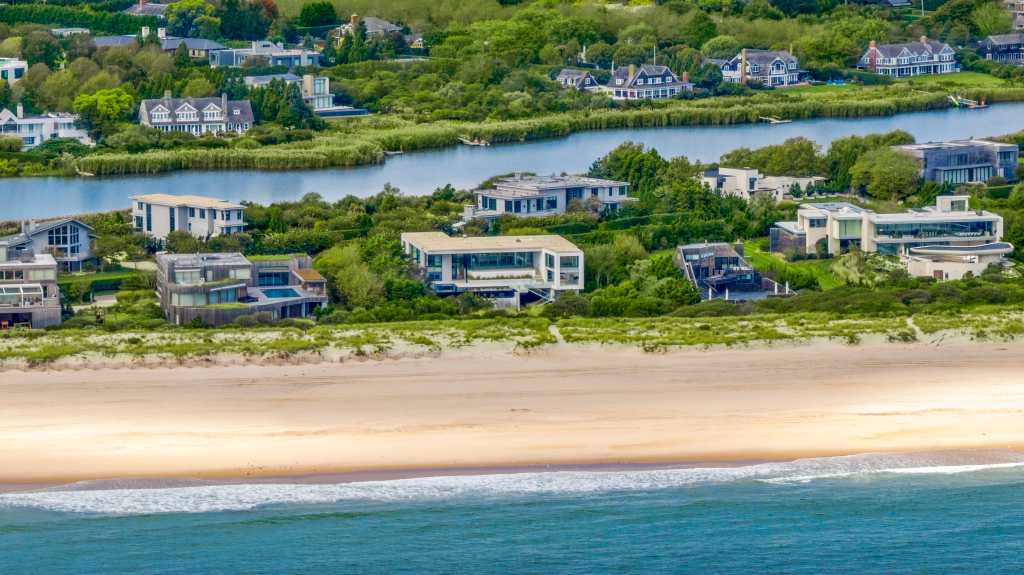Saving Montauk Light: Montauk’s Lighthouse Scheduled to be Torn Down in the 1960’s

The news last week that the federal government has designated the Montauk Lighthouse as a National Historic Landmark brings me to the end of a long story that began almost a half century ago, when I was in my 20s.
As it happened, I was privileged to lead a three-year long campaign all those years ago which, in very dramatic fashion, saved the lighthouse from being torn down by the Coast Guard. The order had been given. I stumbled upon it. What happened after that is the story.
In early July of 1967, I was sitting in the very first office of what became Dan’s Papers, a street-front store in downtown Montauk, trying to think of something to write for the next issue. It was a Monday. We needed to go to press Tuesday. I couldn’t think of anything—at first.
I then recalled reading in Newsday a story about the erosion out at Montauk Lighthouse. The week before, a Coastguardsman had gone out to the front of the lighthouse and, as they did once every year, measured the distance of it from there to the edge of the nearby cliff. When it was built, that distance was 297 feet. Since the lighthouse was built, the bluff had been eroding at a rate of about one foot or more per year, and it was now around 67 feet. They were losing the battle. I did some mathematics. By about 1985 at that rate, the Lighthouse would be falling over the edge. I wondered if the Coast Guard had thought of this. I could write about THAT.
I picked up the phone and called the Montauk Lighthouse. At that time, the Lighthouse was off-limits to the general public. It was owned and operated by the United States Coast Guard. There was work that the lighthouse had to do to protect our shores. The Coastguardsmen saw that it did it.
“Coastguardsman Third Class Collins,” the man on duty answered.
I told him what I wanted to write about, and I wondered if there was anything special in the works to deal with the erosion that would, in 30 years, result in the lighthouse falling down.
“That’s not our problem,” the Coastguardsman said. “We have orders that the Lighthouse is to be torn down. We are going to build a steel tower100 feet high and 1,000 feet from the edge. The light will be on the top. They are out there surveying for the spot next week. There will be no need for the Lighthouse at all.”
I was so shocked I nearly fell out of my chair.
In the next half hour, this is what I learned. The headquarters for the Atlantic Area Coast Guard was on Governor’s Island in New York Harbor at the time. Orders came from there. The Coast Guard was having a budget crunch. They were in the process of abandoning all lighthouses that they felt they did not need. They had just torn down one off the coast of Virginia. Montauk was next on the list. The person I spoke to there read me the brief order authorizing the work. He even gave me the order number.
To me, the Montauk Lighthouse was like the Empire State Building. Montauk would be nothing without it. This could not be allowed to happen. I’d have to do something, but what? Certainly I could write about it.
I have to say, writing this today, that it is hard to believe that back then, people had such a lack of regard for any history. But it was true. Back then, there wasn’t the slightest interest in preservation or the environment. It was all about business. Also there was a war going on in Vietnam.
Later that day, a young railroad buff named Ron Ziel came by my office. I only knew him at this time as someone interested in steam engines and railroads. He’d had an idea. At his house in Bridgehampton he had put a sign on his front lawn that read THE SAG HARBOR AND SCUTTLEHOLE RAILROAD. He wanted to start a tourist train business in the Hamptons.
I interviewed Ron about his plan—I would give him some ink in the paper that next week, and after we were done with that, I told him what was about to happen to the Montauk Lighthouse. I had to do something.
“I’ve seen a picture of the Hampton Bays Lighthouse being torn down with dynamite,” Ron said. “It’s at a barbershop I frequent on the wall there. This could really happen.”
“I didn’t know there was a lighthouse at Hampton Bays,” I said.
“There isn’t now,” he said.
The next issue of the newspaper featured a full page photo of the lighthouse in Hampton Bays, called the Shinnecock Lighthouse, being destroyed. You could see a puff of smoke half way down. Below it, the lighthouse was standing straight. Above it the lighthouse was at a 45 degree angle. What a shot.
The headline I wrote for this was two words, and the two words were absolutely intended to scare everybody. LIGHTHOUSE DYNAMITED! it read. Here in Montauk, that could only mean the Montauk Lighthouse.
In the article, I wrote that this indeed could mean the Montauk Lighthouse. This is what happened in Hampton Bays. I also wrote that the newspaper would be having a protest against this possibility in the parking lot out at the Lighthouse on a Saturday night in August 1967 just after dark at 9:30 p.m.
“Bring blankets and lights,” I wrote. “Bring lanterns, flashlights, torches, flaming batons, candles. We need thousands of people up there. We will shine our lights at the lighthouse for 30 minutes.”
At this time, I was just a few years out of college. I had been the social director of my class in college. I knew everything about big events such as this and how to do them. The Coast Guard would not soon forget this protest.
The protest occurred on a starry August night. The New York Times wrote about it the next day. They reported that there were 3,500 people there. Indeed I had drummed up a lot of interest in this during the one-month interval between LIGHTHOUSE DYNAMITED and the protest. The Montauk Fire Department was there in case anything got out of control. So were the local police. I had politicians at the event, speaking to the crowd over the firetruck sound system. I had a drum and bugle corps from Amityville. I had a band that played bagpipes. I had a troop of women in costume that threw around flaming batons. During the half hour of the protest, just one snare drum played and everyone was quiet. This was surely one of the most amazing events ever held in Montauk.
The result was—nothing. I tried to reach the Coast Guard but got rebuffed, reminded this was none of my business. I said it was my business.
In the weeks that followed, I learned an extraordinary thing about the Montauk Lighthouse. I had never known this before. The Montauk Lighthouse had been authorized built by President George Washington. It was the first lighthouse built in the State of New York. How could it not be saved?
Still nothing happened. And a year later, we held a second protest out at the Lighthouse, on the anniversary of the first the year before. The crowd was smaller. The estimates were 2,000 people. And this time something extraordinary happened. At that time, the Coastguardsmen lived in the house that is connected to the lighthouse. (It’s a museum today.) What we saw that night were Coastguardsmen at the windows of their home, shining flashlights and lanterns back at us. They were with us.
After this second protest, I got a letter from the President of the Franklin National Bank, which was based in Franklin Square and grew to become the nation’s 20th largest bank. If there were anything he could do about this situation, he wrote, just let him know. It did not pass my notice that the logo of the bank’s name, on the top of the stationery sent to me in his letter, included a sketch of the Montauk Lighthouse, shining a beam out across the land.
I wrote to as many people as I could at this point. I got a letter back from Senator Robert Kennedy offering to help and congratulating us for our efforts. I framed this letter. I still have it.
More articles were written in my newspaper and in other publications.
One day, I was visited by an older couple, Donald and Giorgina Reid. They owned a waterfront home on Long Island Sound in Rocky Point and after one bad storm nearly 10 feet of their yard had slipped down the 100 foot cliff into the sea. Giorgina had brought with her a book she wrote entitled How to Hold up a Bank. It described an extraordinary way to stop erosion by using four-inch wooden planks to make little steps up the cliff and planting it with beach grass. The effect was stunning. The grass grew, the roots took hold. The erosion stopped. “This worked at our house,” she told me. “I can do this at the Montauk Lighthouse.”
“You’ll have to ask the Coast Guard for permission,” I said. “Hopefully they’ll let you do that.” But I really thought there was no chance of it.
I was wrong. The Coast Guard allowed her and her husband and several volunteers to come out and install the foliage on Sunday afternoons, but only after they signed releases and showed them injury insurance policies that indemnified the Coast Guard. Their project began in June, 1970.
I thought this might last six weeks or so to plant this cliff, but I was wrong. Giorgina told me she intended to do plantings in a great curve around the cliff extending for half a mile. “We come out every Sunday,” she said. “It will take years.”
It took 20 years and more. After the first year, however, the Admiral at the Coast Guard announced what we already knew, which was that the plan to demolish the lighthouse had been put on hold. But there was something else. The Coast Guard was re-committing itself to the future preservation of the Montauk Lighthouse. His first order in this regard was to give it an entire new paint job. That soon happened. They would preserve it forever and ever.
What I did not know at the time was that the Montauk Lighthouse had been nominated by the State of New York and then accepted for the National Register of Historic Places. I had never heard of any list of the National Register of Historic Places.
It was this new thing, identifying historic places. It did not then pass my notice that the leader of the Assembly in the State of New York at that time, a man who was about as powerful politically as Sheldon Silver is today, was Perry Duryea of Perry Duryea & Son seafood wholesalers in Montauk. Duryea had also spoken over the fire department microphone to the crowd at both demonstrations.
The creation of this, and the placement of the Montauk Lighthouse on it, had apparently been what was necessary to change the Admiral’s mind.
In 1982, 15 years after the first protest and 12 after the Admiral’s change of heart, I received a letter in the mail inviting me to Governor’s Island to be honored for my work in saving Montauk Lighthouse. I immediately called Giorgina Reid who was still living in Rocky Point and still coming out every Sunday to do plantings, to find out, as I suspected, that she had gotten such a letter too.
We went together to South Ferry, where a ship with an honor guard in dress whites carried us to Governor’s Island. We were given a lunch in our honor, and then we were presented with these framed awards. Hers read CERTIFICATE OF ACCOMPLISHMENT for indeed she was still out there planting things. Mine read CERTIFICATE OF ACHIEVEMENT, I guess because I got it started. This was a very class act on the part of the Coast Guard.
The upshot of all this is that the Lighthouse still stands. Giorgina and her husband finished their work out there in 1986, and numerous others carried on the process until it was finally completed in 1998. I recall going to a ceremony at the lighthouse to honor Giorgina and all she was done. A letter was read aloud to her, over a loud speaker, sent by the President of the United States, Ronald Reagan, outlining her extraordinary efforts and what it meant. By the time she stepped down, she was quite elderly. I recall tears coming to my eyes.
Today the lighthouse grounds and the lighthouse itself are both owned and taken care of by the Montauk Historical Society, which opens it to the public in the summertime and uses the fees and donations that come in to maintain the building.
As for the light itself, it remains way up there at the top of the Lighthouse, administered by the United States Coast Guard through an agreement with the Historical Society.
And so now, engineered by others, comes the designation that will really prevent the lighthouse from ever being destroyed—the designation of the Montauk Lighthouse as a National Historic Landmark.
As for the erosion? Giorgina and her volunteers completed the job.
I believe today the Lighthouse is the same number of feet from the edge of the cliff as it was in 1966.
Imagine that.









